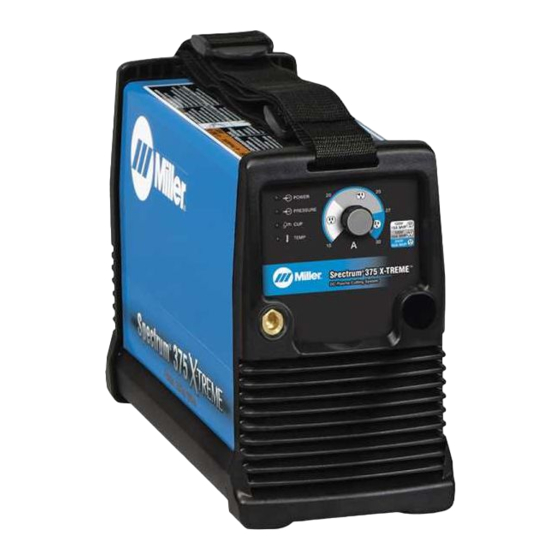Miller XT30 Instrukcja obsługi - Strona 6
Przeglądaj online lub pobierz pdf Instrukcja obsługi dla System spawania Miller XT30. Miller XT30 44 stron. Air plasma cutting and gouging
Również dla Miller XT30: Instrukcja obsługi (40 strony)

� Do not use worn, damaged, undersized, or repaired cables.
� Do not wrap torch cable around your body.
� Ground the workpiece to a good electrical (earth) ground if re-
quired by codes.
� Use only well-maintained equipment. Repair or replace damaged
parts at once.
� Wear a safety harness if working above floor level.
� Keep all panels and covers securely in place.
� Do not bypass or try to defeat the safety interlock systems.
� Use only torch(es) specified in Owner's Manual.
� Keep away from torch tip and pilot arc when trigger is pressed.
� Clamp work cable with good metal-to-metal contact to workpiece
(not piece that will fall away) or worktable as near the cut as
practical.
� Insulate work clamp when not connected to workpiece to prevent
contact with any metal object.
ELECTRIC SHOCK can kill.
SIGNIFICANT DC VOLTAGE exists in inverter
power sources AFTER removal of input power.
� Turn off unit, disconnect input power, and dis-
charge input capacitors according to instructions in
Manual before touching any parts.
EXPLODING PARTS can injure.
� On inverter power sources, failed parts can ex-
plode or cause other parts to explode when power
is applied. Always wear a face shield and long
sleeves when servicing inverters.
ARC RAYS can burn eyes and skin.
Arc rays from the cutting process produce intense
visible and invisible (ultraviolet and infrared) rays
that can burn eyes and skin.
� Wear face protection (helmet or shield) with a
proper shade of filter lenses to protect your face and eyes from arc
rays and sparks when cutting or watching. ANSI Z49.1 (see Safety
Standards) suggests a No. 9 shade (with No. 8 as minimum) for all
cutting currents less than 300 amperes. Z49.1 adds that lighter fil-
ter shades can be used when the arc is hidden by the workpiece.
As this is normally the case with low current cutting, the shades
suggested in Table 1 are provided for the operator's convenience.
� Wear approved safety glasses with side shields under your helmet
or shield.
� Use protective screens or barriers to protect others from flash,
glare and sparks; warn others not to watch the arc.
� Wear body protection made from durable, flame-resistant material
(leather, heavy cotton, wool). Body protection includes oil-free
clothing such as leather gloves, heavy shirt, cuffless trousers, high
shoes, and a cap.
Table 1. Eye Protection For Plasma Arc Cutting
Table 1. Eye Protection For Plasma Arc Cutting
Table 1. Eye Protection For Plasma Arc Cutting
Current Level In Amperes
Below 20
20–40
40–60
60–100
OM-253555 Page 2
Minimum Shade Number
#4
#5
#6
#8
FLYING SPARKS can injure.
Sparks and hot metal blow out from the cutting arc.
Chipping and grinding cause flying metal.
� Wear approved face shield or safety goggles with
side shields.
� Wear proper body protection to protect skin.
� Wear flame-resistant ear plugs or ear muffs to prevent sparks from
entering ears.
NOISE can damage hearing.
Prolonged noise from some cutting applications
can damage hearing if levels exceed limits speci-
fied by OSHA (see Safety Standards).
� Use approved ear plugs or ear muffs if noise level
is high.
� Warn others nearby about noise hazard.
FUMES AND GASES can be
hazardous.
Cutting produces fumes and gases. Breathing
these fumes and gases can be hazardous to your
health.
� Keep your head out of the fumes. Do not breathe the fumes.
� Ventilate the work area and/or use local forced ventilation at the
arc to remove welding fumes and gases. The recommended way
to determine adequate ventilation is to sample for the composition
and quantity of fumes and gases to which personnel are exposed.
� If ventilation is poor, wear an approved air-supplied respirator.
� Read and understand the Safety Data Sheets (SDSs) and the
manufacturer's instructions for adhesives, coatings, cleaners, con-
sumables, coolants, degreasers, fluxes, and metals.
� Work in a confined space only if it is well ventilated, or while wear-
ing an air-supplied respirator. Fumes from cutting and oxygen de-
pletion can alter air quality causing injury or death. Be sure the
breathing air is safe.
� Do not cut in locations near degreasing, cleaning, or spraying op-
erations. The heat and rays of the arc can react with vapors to
form highly toxic and irritating gases.
� Do not cut on coated metals, such as galvanized, lead, or cadmi-
um plated steel, unless the coating is removed from the cutting
area, the area is well ventilated, and while wearing an air-supplied
respirator. The coatings and any metals containing these elements
can give off toxic fumes when cut.
� Do not cut containers with toxic or reactive materials inside or con-
tainers that have held toxic or reactive materials - they must be
emptied and properly cleaned first.
PLASMA ARC can injure.
The heat from the plasma arc can cause serious
burns. The force of the arc adds greatly to the burn
hazard. The intensely hot and powerful arc can
quickly cut through gloves and tissue.
� Keep away from the torch tip.
� Do not grip material near the cutting path.
� The pilot arc can cause burns - keep away from torch tip when trig-
ger is pressed.
� Wear body protection made from durable, flame-resistant material
(leather, heavy cotton, wool). Body protection includes oil-free
clothing such as leather gloves, heavy shirt, cuffless trousers, high
shoes, and a cap.
� Point torch away from your body and toward work when pressing
the torch trigger - pilot arc comes on immediately.
� Turn off power source and disconnect input power before disas-
sembling torch or changing torch parts.
� Use only torch(es) specified in the Owner's Manual.
